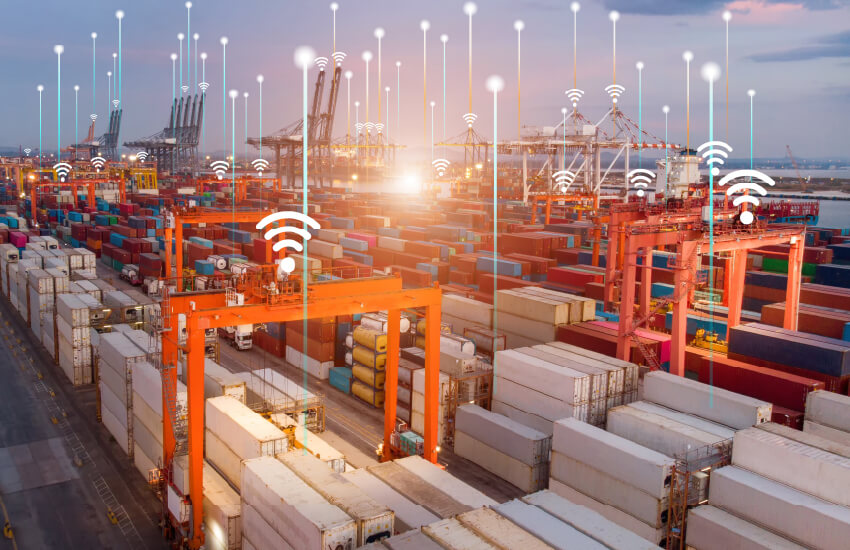by Webbing Team | June 18, 2025
Just like other “smart” facilities – for instance, smart factories or smart mines – smart ports are digitally transformed harbors that use IoT, AI, automation, and data analytics to optimize operations and improve efficiency. Their transformation into “smart ports” began as early as the mid-2000s, with pioneers like the Port of Rotterdam investing heavily in digital infrastructure and automation. Early digitalization efforts focused mainly on port community systems, digital documentation, and basic tracking of containers.
Driven by advances in IoT and connectivity technologies like 4G LTE and 5G, the concept gained momentum in the next decade, and later, the COVID-19 pandemic became a major catalyst for smart port development. Many ports faced severe disruptions due to labor shortages, quarantine measures, and surging demand for goods. Manual processes, such as paperwork handling and on-site inspections, became bottlenecks, leading to delays and congestion, which exposed the limitations of traditional port operations. It pushed ports to adopt more advanced, integrated technologies, and from 2020 onward, many major ports began investing in AI-driven logistics, autonomous vehicles, drone inspections, and private cellular networks.
Cellular connectivity plays a foundational role in enabling smart ports by providing the reliable and secure wireless infrastructure needed to support their digital transformation and real-time operations. Ports are large, complex environments with thousands of moving assets, vehicles, vessels and people, often spread across miles of open yards and warehouses. Traditional networks like Wi-Fi struggle with coverage and interference in such settings. In contrast, cellular networks offer wide-area coverage, low latency, and high device density support, which makes them ideal for powering IoT devices and autonomous systems across the port.
By using cellular connectivity, smart ports can deploy and manage key technologies such as automated cranes and vehicles, asset and container tracking, real-time surveillance systems, drone inspections, and environmental monitoring. Cellular networks enable continuous data flow from a plethora of IoT devices to centralized systems or edge computing nodes, where AI and analytics drive operational decisions.

Cellular Connectivity For Smart Ports: Public Or Private Networks?
Many ports rely on public cellular networks for their IoT deployments. At the Port of Antwerp, public 5G enables real-time HD video streaming from vessels for remote navigation in congested areas. Public networks can effectively support IoT applications in port environments, especially when scalability and rapid deployment are prioritized.
However, as operational demands increase, many ports consider transitioning to private or hybrid networks to gain greater control over performance and customization. High-density, security-sensitive, latency-critical applications may require private architecture. Besides, with a private network, port authorities can define network priorities, enforce quality of service (QoS) policies, and customize certain performance parameters, which is not possible on a shared public network.
Recently, many ports have deployed private networks, and their use cases show how versatile these networks can be. The Freeport of Riga uses a private 5G maritime network to enable real-time communication between the port, ships, and autonomous sea drones, and extend connectivity over 100 miles offshore through multi-hop relays. The Port of València is deploying a private 5G network to connect over 25,000 devices and support applications like surveillance, remote maintenance, digital twins, and stowage planning.
Some of the private network projects can also showcase the benefits of cellular technology compared to traditional means of wireless connectivity. For instance, the Tacoma Port Project achieved 10x the coverage of traditional Wi-Fi using just two CBRS 5G base stations versus 20 Wi-Fi hotspots. Moreover, the port has seen a 500% increase in available bandwidth, enabling faster data transfers, HD video surveillance, and remote diagnostics. Notably, CBRS-based 5G deployment costs are about one-sixth that of Wi-Fi, and when matched for coverage, offer a cost efficiency ratio of 60:1.
Let’s take a look at the main use cases that cellular connectivity enables in smart ports:

Asset Tracking and Container Management
Ports handle thousands of containers daily, and the ability to monitor their location and condition is crucial. Cellular-enabled sensors attached to containers and cargo-handling equipment provide continuous data on position, temperature, vibration etc. This data helps reduce loss and prevent cargo theft, but more importantly, it allows to improve logistics planning.
Cellular networks enable reliable wide-area coverage even in dense port environments where Wi-Fi signals often fail. Cellular networks allow these devices to transmit data continuously and securely as they move across terminals and yards.
Vehicle and Equipment Telemetry
Ports rely on a wide array of mobile machinery such as cranes, trucks, forklifts, and automated guided vehicles (AGVs). Monitoring their fuel consumption and maintenance status in real time helps prevent breakdowns and improve operational efficiency. This is especially critical in high-traffic terminals where downtime can be costly.
Cellular connectivity allows telemetry data to be transmitted seamlessly from moving vehicles. With 5G, low latency enables fast data exchange between vehicles and control centers, supporting real-time decisions and predictive maintenance. The Port of Tianjin in China, for instance, uses a 5G-enabled smart terminal to gather telemetry from autonomous cranes and vehicles.
Security and Surveillance
Smart ports deploy cameras and sometimes drones to monitor cargo areas and perimeter fences. These systems require robust and continuous video feed, often in HD, and oftentimes are deployed in areas where laying fiber is either impractical or too expensive.
Cellular networks, particularly private 5G, support the high bandwidth and ultra-low latency required for real-time video streaming and drone telemetry. With SIM-based security and traffic segmentation, they also ensure that sensitive surveillance data remains isolated from other traffic. For instance, the Port of Antwerp has trialed drones connected via public 5G for perimeter surveillance, delivering live video to security teams and improving incident response times.

Smart Gate Systems
Smart gates automate the verification and flow of trucks entering and exiting port facilities. These systems integrate many systems, including license plate recognition (ANPR), digital documentation, and biometric access. They must always remain online, and, like security cameras, may be deployed in locations where fixed network access is unavailable.
Cellular connectivity ensures these systems remain continuously connected, even during outages or in remote gate locations. With edge computing capabilities, data from cameras and sensors can also be processed locally, reducing latency.
Environmental Monitoring
Since ports are major sources of emissions (for example, ports of LA and Long Beach are responsible for about a fifth of the Los Angeles region’s nitrogen oxides), noise and water pollution, regulatory compliance requires constant data collection. Special sensors that measure air and water quality, as well as noise levels, are deployed throughout port areas to help detect pollution incidents and drive sustainability efforts.
Cellular technology makes it easy to deploy and maintain remote environmental sensors without building a dedicated fixed infrastructure. These sensors can send real-time data over cellular networks back to centralized systems for analysis and alerting.

Connectivity Requirements of Smart Ports
As can be seen from real-life examples, smart ports rarely use cellular connectivity for only one application. But no matter how customized each use case may be, certain connectivity features are critical for all cellular-enabled IoT deployments in smart ports.
Coverage
Smart ports span large areas that include open yards, warehouses, terminals, and even offshore zones. Cellular networks offer reliable wide-area coverage that ensures seamless connectivity across the entire port. This is especially important for tracking moving assets and connecting remote equipment without signal drop-offs, unlike Wi-Fi which may struggle with range and interference. Also, to address the problem of coverage gaps that each mobile network may have and ensure continuous coverage, it is important that devices can connect to multiple networks in the area.
Latency
Real-time applications like remote crane control, or automated guided vehicles (AGVs), or live video surveillance all require ultra-low latency. Even non-real-time automated systems without low latency risk delays that can cause errors or downtime, so latency is critical for smart ports.
5G networks can deliver latencies as low as 1 millisecond, though actual performance depends on the architecture of the connectivity provider’s core network.
Seamless Connectivity
Along with access to multiple networks, seamless connectivity is critical. For drones and AGVs the capability of switching between different mobile carriers’ networks without losing connection is a very important feature. Since port facilities can get huge and include spots where certain carrier’s network signal is unstable, it is critical.
This problem of stable connectivity was one of the reasons why smart ports started deploying private networks. However, this introduced a new complexity, as devices often need to maintain connectivity while moving between private and public networks. For example, a sensor-equipped vehicle might operate on a private 5G network inside a warehouse, then transition to a public network once outside. Some devices may also use public networks as a backup if their connection with the private network is lost. Therefore, it’s crucial that they could make a seamless transition between public and private networks, as well as between different public networks.
Compliance With Connectivity Regulations
Most countries today have data privacy, data protection and sovereignty regulations that apply to all industries. Ports must comply with these data sovereignty or localization laws, especially when handling cross-border trade data. Additionally, as critical infrastructure, ports may be required to support emergency communication protocols and ensure network resilience. Given these demands, a connectivity provider’s ability to meet regulatory compliance standards can be a key consideration when selecting a connectivity solution.

Webbing’s Connectivity Solution for Smart Ports
Webbing offers a connectivity solution that ensures global access to reliable and high-quality internet, with low latency and the best of class coverage. It provides secure and continuous internet connection for all types of devices used in smart ports, wherever and whenever they need it.
Webbing’s partner network of over 600 mobile operators worldwide guarantees global coverage. It allows to roam on several carriers’ networks in every region, solving the problem of weak spots that any mobile network may have and ensuring full coverage and continuous connectivity even at remote locations.
Webbing is a global connectivity provider with a distributed full core network with local breakouts, multiple network solution, and data server redundancy that provides connectivity stability and low latency. As such, Webbing’s network allows for realization of most complex scenarios with different types of devices, high-data consumption and industry-specific requirements
Our eSIM solution guarantees failover connectivity with the capability of using multiple mobile carrier profiles, easily changing carriers at any time with zero integration, and an option to fall back from a failing profile to a different profile without any need to communicate with a remote server or deal with multiple SIM cards. It helps enterprises that need access to private and public networks to ensure continuous data connectivity for their devices. Easily set business rules help determine automatic profile allocation and enable fallback mechanisms in case of private network failure or coverage issues.
A flexible approach to data packages allows us to tailor our connectivity offering for every customer based on the type of connected devices and their data consumption needs as well as the locations where the devices are used, aiming at overall optimization of the total cost of operations for the client.
Our solutions help enterprises overcome their connectivity challenges and optimize costs for global IoT deployments, providing the benefits of roaming with multiple carrier options in every country, and seamless transition between carriers, public and private networks, while maintaining low rates and low latency on a global scale with a single SIM.
Reach out today to learn more about Webbing’s customized connectivity solutions for smart ports.




